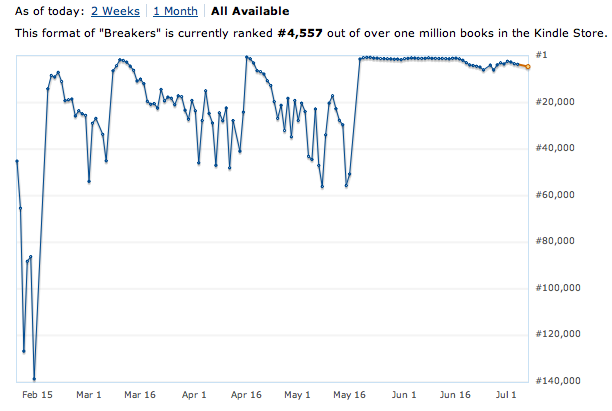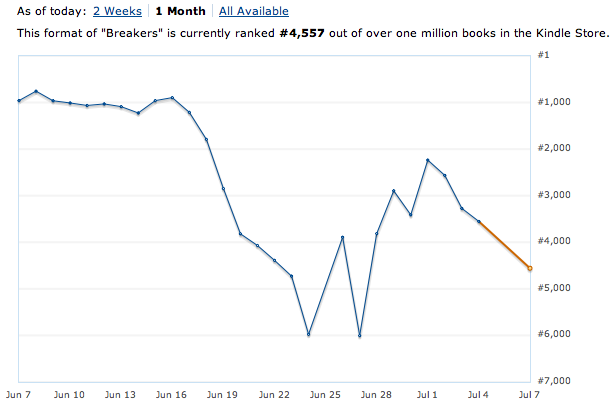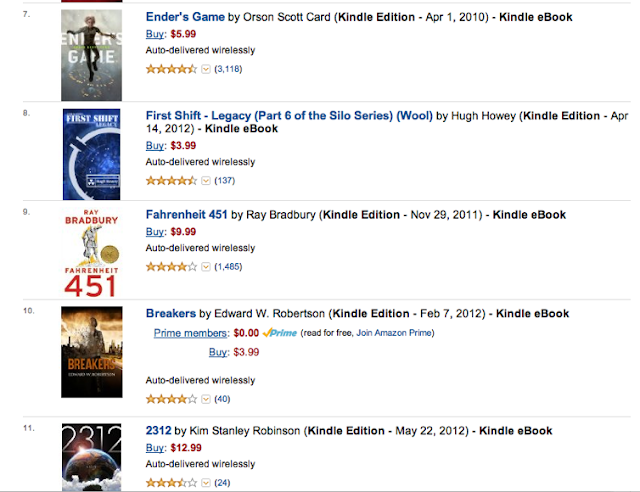Last time I looked at Amazon’s current algorithms, I speculated what would happen 30 days after Breakers‘ giant free run. At that point, all the free copies it gave away would stop counting towards its rank on the popularity lists. That was a frightening prospect, but at the same time, I’d racked up some 2300 paid sales (and another 600 borrows) in the 30 days since my giveaway. Would those be enough to sustain my place on the pop lists? If not, what would happen? Would I face a slow decline, or a swift one? Would I stroll down a hill, or smash down a cliff?
Well, here’s a look in chart form. Here’s Breakers‘ entire sales history:
 |
| Pictured: D’oh |
That doesn’t look so bad. That nice, flat line goes on forever and ever. It’s just a little jagged there at the end is all. Wait, let’s take a closer look:
 |
| Pictured: D’oh, Part 2 |
Okay, that’s a better look at what happened. What we’re seeing here is twofold. First, notice that downward slope starting around June 16? That’s when my free days stopped counting. The descent was swift–nearly 1000 ranks a day until I hit #4000, when the decline slowed. That is not a gentle hill. That is a brutal cliff. The drop from #1000 Paid to #2000 Paid is the difference between roughly 70 sales per day and about 40 sales/day. And rank declines more slowly than it rises, meaning my drop was even stiffer than that. Within a week of my free days beginning to roll off, I’d dropped from #1000 to #5000. In terms of daily sales, that was a drop from 50-70/day to 10/day.
I had braced myself for it, but it’s hard to brace yourself for a freefall. Mostly what happens at the end of the cliff is a puddle composed of you.
“But wait,” you say. “Bottoming out at #6000 isn’t so bad. That’s a pace around 500 sales/month. And anyway, rank spiked just a few days after that, taking you back to #2000. What are you bitching about?”
What am I–? Look, we’ll get to that in a moment, Captain Impatience. First, I want to talk about the why some more. Why such a steep decline? After all, my bestseller rank was still really good. #1000 overall, which was something like #8 in Technothrillers and #22 in Science Fiction > Adventure. That’s quite a bit of visibility, isn’t it? And what about also-boughts? At that point, I had a lot of popular sci-fi books pointing back to Breakers in the form of the “Customers Who Bought This Item Also Bought” lists.
Well, it turns out those things just aren’t all that important. Ha ha! That is way too flippant of an answer. Totally misleading. In truth, bestseller rank and alsobots clearly matter to some degree, but the more I do this, the more dismissive I am of them in general: while they certainly help generate sales, the bestseller lists are so volatile your book can sink extremely rapidly, and the alsobots are such a harsh filtering process (basically, your book needs to be on the first page of a book that has just been finished by a reader who is interested in buying another book right now) that they are of limited use. I think if you have a very high bestseller rank, or first-page placement on the alsobots of a very popular book, then that can do a lot for your sales, but otherwise, those are the supporting cast to a book’s sales, not the star.
The star is the popularity lists. And your book isn’t on just one of them, it’s on a bunch. For instance, one of Breakers‘ category paths is Kindle Store > Kindle eBooks > Science Fiction > Adventure. Each of those is a separate popularity list, which means the book is listed (somewhere) on each of them. Say it’s showing up at #20 on > Adventure; that would place it somewhere around #40-50 in > Science Fiction, and somewhere like #1200-1600 in > Kindle eBooks. In terms of discoverability, it would be very easy to find in SF > Adventure (second page), pretty easy to find in > Science Fiction (page 4-5), and totally awful in > Kindle eBooks (page 100+). No one is going to click through 100 pages in the eBooks category to find it. But this is part of the reason mega-popular books like 50 Shades of Grey or The Hunger Games stay so sticky for so long: when you’re #1 in the store, everyone sees you every time they visit Amazon. Plus the whole “world-destroying word of mouth” thing. But extreme visibility in high-traffic categories leads to a lot of clicks on your book, which in turn generally leads to a lot of sales.
That’s essentially why Select free runs used to do so well on the old pop lists. And that’s why taking a sudden tumble from, say, #10 in > Science Fiction (where I peaked)–the first page of the entire category–to #40-50 or wherever makes such a big difference. And remember, you’ve got another subcategory you’re listed on, too. Once your visibility is lost when a big free run rolls beyond the pop list window, you’re not going to regain it without another push.
 |
| Breakers’ peak rank on the Science Fiction popularity list a week before I ate cliff |







Leave a Reply